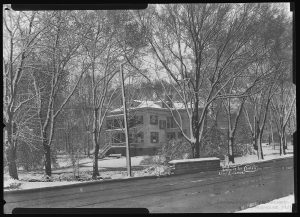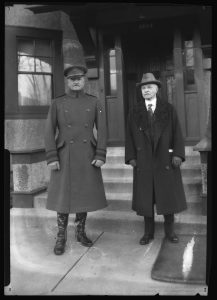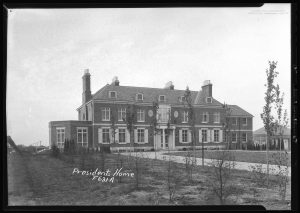For this week’s Tales from the Nitrate Negatives, we wanted to try something a bit different from usual. Instead of focusing on a single historical event documented through nitrates, we’re tracing the evolution of a house. More specifically, we follow the history of the houses of the presidents of the University of Illinois as captured in Bernard Strauch’s nitrate films. It’s been an expectedly tricky process to track down a couple house from over a century ago, especially if half houses were torn down in the mid 1900s. It is no walk in the park strolling through 18th and 19th century city housing directories so detailed that they person’s race, marriage status, and even their job. Thanks to a century and a half of Champaign-Urbana growth, what was 905 East Green Street back in 1890 could be halfway through the 1400 block of West Green Street in 2022. With directories, photographs, and even presidential biographies, we got hot on the case hunting down homes. At one point, we even tracked down Regent Gregory’s library card to see if he had an alternate address we needed to track down. This project, ostensibly a small history stemming from Strauch’s pictures of one presidential home turned into a dive into Champaign-Urbana lore. Through more than 150 years and 19 presidents of the University of Illinois, we present Home Sweet (Presidential) Home.

Our history starts back in the late 1860’s when John Milton Gregory first came to Champaign, Illinois from Kalamazoo, Michigan as part of his quest to help build the young Illinois Industrial University. Gregory, appointed as the first Regent by the board of trustees, paid for the construction of his home at, then, 709 South 4th Street, Champaign Illinois. It was a quaint, two-story, brick house with a patio lightly extended into the front lawn and ivy growing up the columns. Some things don’t really change do they? By the University’s first year, Gregory was a notable figure in the Champaign-Urbana community! Regent Gregory lived in this home all 13 years of his presidency, and for a year after his retirement before he returned home to New York. The property of Gregory’s house was purchased by the Alpha Delta Pi fraternity in 1912, and then razed for the construction of the University’s first Alpha Delta Pi chapter house.
Following Gregory’s tenure, Regent Selim Hobart Peabody was appointed to the presidency by the Illinois Board of Trustees. Before his presidential term, Peabody was a professor at the University. In his early days of teaching, Peabody was reluctant to fully commit to Champaign and leave his family’s Chicago home behind. In a biography of Regent Peabody written by his daughter, she notes that he was invited by Regent Gregory to live with him for a few months before he full decided to establish a residency. Arguably, we could call Gregory’s home on 4th street the first “President’s House” handed down between presidents because two university presidents technically both occupied it. After committing to Illinois and fully transitioning his family to Champaign, Peabody moved into a home at 709 Mt. Hope Avenue. This house remained the President’s home during his tenure at the university. Unfortunately, neither the building nor Mount Hope Avenue exists today. Mount Hope Avenue was renamed Pennsylvania Avenue in the mid 20th century, and Peabody’s home was razed in the 1940’s to make room for the rapidly expanding University of Illinois.

Continuing the pattern formed by the first two regents, Peabody’s successor, Thomas Jonathan Burrill, simply transformed his home from his time as a professor to become the President’s house. Located at was once 1007 West Green Street, Burrill’s home occupied the land between where the Hendrick House Residence and the University Astronomy Building currently reside. Not much could be traced about this house beyond the fact that the 1898 housing directory notes that Burrill lived there for almost 5 years after his term as president ended before it disappeared from public record.

Beginning with Andrew Sloan Draper’s Presidency, we see the first true rotating home of the president. His home was a well-kept house offset a stone’s throw north of the Green and Wright Street intersection. This nice estate nestled up against the Boneyard Creek was located at 905 W. Greet Street, and would now reside at 1410 West Green. It was purchased for the Draper by the University as a official President’s home for his time here. Beyond building a legacy of expansion and a connecting the University to the peaks of American industry, Draper built the historical legacy of a presidential manor handed off when he was succeeded by President Edmund Janes James in 1904. President James occupied the same Green Street residence bringing with him small expansions like a nice greenhouse out back and a drastically reworked landscape job around the property. The University finally started the dream of having a single president’s house that could be passed on through generations. Though it’s a simple gesture now, at the time having an official President’s house added a sense of prestige and community to the University.

Unfortunately, that dream of a generations-long house did not last. Following James’s Tenure, President David Kinley opted for a more conservative choice, preferring to stay in his Urbana home from his time as a professor. David Kinley’s home, a nice 2 story building just off Nevada street is still standing to this day. Located at 1203 W Nevada St in Urbana, Illinois, his home was purchased by the University of Illinois after his departure. It was eventually given and was given to the La Casa Cultural Latina, the latino/a cultural house in 1974.
President David Kinley retired in 1930 before Harry Woodburn Chase was appointed to the presidency. Chase returned to the former presidential manor off Green Street for a bit under a year before moving to the permanent presidential home. Consequently, the former president’s home off Green Street was appropriated by the university as a temporary student health center in the mid 1920’s. It also served as a student organization home after the student YMCA relocated its services from University Hall. They occupied that location for half a year before moving to their current Wright Street location. President Chase was the first to occupy the new, and current, president’s house on Florida Avenue. Chase’s time as President during the Great Depression forced him to deal with a tight economy, and an even tighter university budget following the stock market crash of 1929. With his limited funding, he continued the completion pre-depression Board of Trustees project to construct a new and continuous president’s house in 1930 for a cost of $225,000 ($4.2 million today).

The 14,000 square-foot Georgian revival style building. was designed by the campus’ supervising architect James M. White, and Charles Platt of the Holabird and Roche architectural company. Holabird and Roche had designed a majority of the new buildings on campus of that era, and the president’s house was set to match the standard. James moved into the residence, located at 711 W Florida Ave, Urbana, and it’s remained the university standard for over 90 years. From President Chase to David Dodds Henry, from Stanley Ikenberry to Timothy Killeen, the home of the president has remained constant to this day.